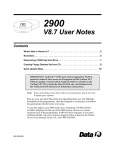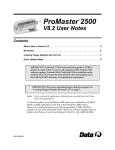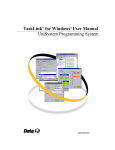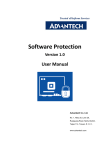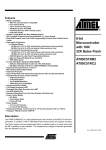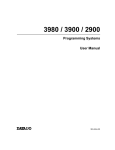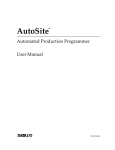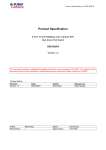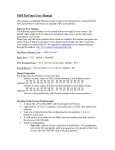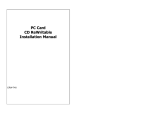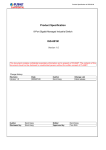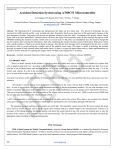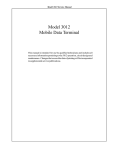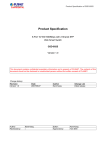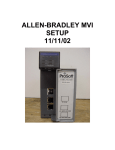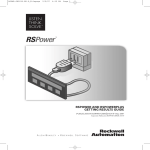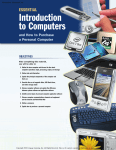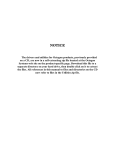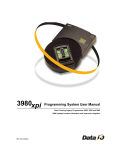Download Version 8.7 User Notes
Transcript
AutoSite ™ V8.7 User Notes Contents What’s New in Version 8.7 . . . . . . . . . . . . . . . . . . . . . . . . . . . . . . . . . . . . . . . . 2 Reminders . . . . . . . . . . . . . . . . . . . . . . . . . . . . . . . . . . . . . . . . . . . . . . . . . . . . 5 Determining if Programmer Has Hard Drive . . . . . . . . . . . . . . . . . . . . . . . . . . . 7 Creating Floppy Diskette Set from CD . . . . . . . . . . . . . . . . . . . . . . . . . . . . . . . 8 Quick Update Steps . . . . . . . . . . . . . . . . . . . . . . . . . . . . . . . . . . . . . . . . . . . . 10 IMPORTANT: TaskLink™ DOS users need to upgrade to V2.09 or greater in order to have access to all supports in this UniFam V8.7 software update. Version 2.09 of TaskLink DOS is available on the UniFam V8.7 CD or from the Data I/O Web site. See Readme.txt in the TaskLink DOS directory for installation instructions. IMPORTANT: For issues regarding floppy diskette support, see “Creating Floppy Diskette Set from CD” on page 8. Note: You do not need to update your software if you received these User Notes with a new programmer. IMPORTANT: Before completing the appropriate Quick Update, see “Determining if Programmer Has Hard Drive” on page 7. To use this update, your AutoSite must have a minimum of 2 MB of RAM available (displayed at the top of the AutoSite screen). However, to make maximum use of the programmer, 8 MB of RAM is required. If you need additional RAM, call your Customer Support office as listed in the Preface of your User Manual. In the U.S., call 1-800-332-8246. 984-1022-052 What’s New in Version 8.7 Device Lists on “UniFam 8.7/TaskLink 7.30” CD Lists of new and updated devices can be found on the “UniFam 8.7/TaskLink 7.30” CD in \Update_Info. Update from “UniFam 8.7/TaskLink 7.30” CD The “UniFam 8.7/TaskLink 7.30” CD contains all the software required for updating your programmer. TaskLink™ for Windows® allows for easy installation of “UniFam 8.7” CD contents (Boot File, System Files, and Algorithm Sets). For instructions on how to install “UniFam 8.7” programmer software from CD, see TaskLink for Windows Help and select “How to Update System Software.” Please note that after inserting the “UniFam 8.7/TaskLink 7.30” CD into your CD drive, the TaskLink install program will begin. If you do not wish to install the latest version of TaskLink, simply close the TaskLink install program. You must use TaskLink 4.50 or greater to install your UniFam V8.7 programmer software update. Note: Software updates from CD work only on programmers with a hard drive. Contact Data I/O Sales for information on upgrading your programmer to a hard drive. Philips Semiconductor Changes Effective in V7.3, Philips Semiconductor requested that we update the following device menu selections to conform with their latest programming specification changes: AutoSite V8.7 User Notes Old Name Now Called 89C51RB2 89C51RB2H 89C51RB2-PLC 89C51RB2H-PLCC 89C51RC2 89C51RC2H 89C51RC2-LQFP 89C51RC2H-LQFP 89C51RC2-PLCC 89C51RC2H-PLCC 89C51RD2 89C51RD2H 89C51RD2-PLCC 89C51RD2H-PLCC 2 Devices Now Listed under SST Only Prior to the V7.9 update, the devices listed below were located under both Manufacturer: SST and Manufacturer: Silicon Stor. Starting with V7.9 and thereafter, these devices are listed only under Manufacturer: SST. Device Name Package Pins 39VF512 DIP 32 39VF512-PLCC PLCC 32 39VF512-TSOP TSOP 32 39VF010 DIP 32 39VF010-PLCC PLCC 32 39VF020 DIP 32 39VF020-PLCC PLCC 32 39VF020-TSOP TSOP 32 39VF040 DIP 32 39VF040-PLCC PLCC 32 39VF040-TSOP TSOP 32 29EE512 DIP 32 29EE512 PLCC 32 29EE512 TSOP 32 29EE010 DIP 32 29EE010 PLCC 32 29EE010 TSOP 32 29EE020 DIP 32 29EE020 PLCC 32 29EE020 TSOP 32 TaskLink DOS Version Requirement TaskLink DOS users need to upgrade to V2.09 or greater in order to have access to all supports in this V8.7 software update. Version 2.09 of TaskLink DOS is available on the UniFam V8.7 CD or from the Data I/O Web site. See Readme.txt in the TaskLink DOS directory for installation instructions. AutoSite V8.7 User Notes 3 Mitsubishi Electric and Hitachi Transferred to Renesas Technology Corp On April 1, 2003, the semiconductor operations of Mitsubishi Electric and Hitachi were transferred to Renesas Technology Corporation. These operations include microcomputer, logic, analog and discrete devices, and memory chips other than DRAMs (flash memory, SRAMs, etc.). Beginning in V7.4, a new menu selection appeared for Renesas Technology Corporation. As a result of this transfer: All devices currently distributed by Renesas Technology Corporation are found under the "Renesas Tech" menu selection. All new supports (devices) distributed by Renesas Technology Corporation, regardless of the Mitsubishi or Hitachi part markings, are found only under the “Renesas Tech” menu selection. All existing supports for Mitsubishi or Hitachi devices currently marketed by Renesas Technology Corporation are found under both their previous menu selections and the “Renesas Tech” menu selection. This dual listing prevents problems with customer Tasks. AutoSite V8.7 User Notes 4 Reminders Data I/O’s Web Site Replaces ‘Device List on Disk’ Have you been using the Device List on Disk for your device information? As we announced in an earlier edition of these User Notes, we have upgraded our device support and information tools to take advantage of the power, speed, and accessibility of the World Wide Web. Since the release of V6.1, all our device support information, device footnotes, and capacitor block configuration information is on the Web. Our Web address is http://www.dataio.com. Data I/O has stopped distributing the Device List on Disk. If you would like a device list, download it from http://www.dataio.com/ftp/device_lists/pm3000.txt Changes to Computer Remote Control (CRC) in V6.8 Beginning with V6.8, new CRC commands were added for: Programmer type query Device type query Device Electronic ID query Fill RAM with non-repeating test pattern Device list query Selection for checksum type Stand-alone device erase operation Updating programmer software For specific information about these new CRC commands, please see the updated UniSystem Computer Remote Control application note (983-0490-005) available on the Data I/O Web site at http://www.dataio.com. Beginning in V6.7, the 49] command in CRC mode first issues a prompt before returning to Terminal Mode so that XPI programmers can return an error message if nothing is connected to the serial port. Changes to Terminal Mode in V6.8 Beginning with V6.8, the “Device Configure Edit” screen appears under the Main Menu in Terminal Mode when a device is selected with options that can be edited. For all other device types, the More Commands menu is positioned lower on the screen than in previous versions. Note that the “Device Configure Edit” screen is also still available from the More Commands/Device Checks/Device Configure menu. The appearance of the “Device Configure Edit” screen changed in V6.8. With some newer sectored devices, it became possible to set the Begin Device and Device Block Size parameters from the “Device Configure Edit” screen. Also, the control-K option (^K) was added in V6.8. Pressing ^K changes the display and entry of sector information to an abbreviated mode useful for devices with a large number of sectors. Please refer to the Help feature for more information. In V6.8, Device operation block limit parameters are reset to defaults when a new device type is selected. In earlier versions, device operation block limit parameters were reset only if their values exceeded the size of the newly selected device. AutoSite V8.7 User Notes 5 Improved Checksum Calculation With Devices Using Sector Protect This change only affects filling the programmer RAM with “FF” before you program a 16-bit device. In versions of software before V5.9, if you entered sector protect data, only the least significant byte of the 16-bit word in RAM was changed. For example, if you entered sector protect data “01”, the 16-bit word would read “FF01”. All sectors were protected correctly but a different device checksum was calculated because the “FF” in the most significant byte (“FF01”) was added into the device checksum. In software V5.9 and later, when you enter sector protect data “01”, the 16-bit word in the programmer’s RAM will be entered as “0001”. This modification was made so the high order byte does not change the device checksum reported at the end of the programming cycle. Names Indicate Location of Configuration Blocks The last four characters of the entries in the Device List “Base” column indicate the capacitor configuration block locations. Note: The Programming Module Configuration chart in your handler User Manual is no longer applicable. PPI Adapter information is Displayed in the Message Bar When you are using AutoSite in local mode, the name of the required adapter is displayed in the message bar if a PPI adapter is needed for a device operation. AutoSite V8.7 User Notes 6 Determining if Programmer Has Hard Drive To determine if your programmer has a hard drive, go to the Main Menu (press F1 to return to the Main Menu) and go to: More Commands/Configure System/Mass Storage If you do see Mass Storage at the lower left side of the Configure Systems/Parameters menu, you have a hard drive. If you do not see Mass Storage at the lower left side of the Configure Systems/Parameters menu, you do not have a hard drive. Turn to the Table of Contents on page 10 of these User Notes to select the appropriate Quick Update Steps for your programmer. AutoSite V8.7 User Notes 7 Creating Floppy Diskette Set from CD If your AutoSite does not have a Mass Storage Module (MSM), you will need to perform the following steps to create a set of system floppy diskettes from the “UniFam 8.7/TaskLink 7.30” CD. If you would like more information regarding upgrade options, call your Customer Support office as listed in the Preface of your User Manual. In the U.S., call 1-800-332-8246 (1-800-3-DATAIO). You will need high density 1.44 MB 3.5" floppy diskettes for the complete disk creation process. High density diskettes have the “HD” logo embossed on the plastic disk jacket. See below. High Density Diskette Blank 3.5" floppy diskettes are probably available at your local computer or office supply store. Additionally, these online vendors ship internationally and carry diskettes suitable for use with Data I/O products: http://www.compusa.com or http://www.cdw.com 1 Boot your programmer using a previous version of software. After the programmer is booted, enter terminal mode. In TaskLink for Windows, click Tools >Programmer Interface to enter terminal mode. In TaskLink for DOS, click Utilities > Programmer Interface. 2 In terminal mode, press the following keys: F1, M, F, F. This moves you through the menu to the FORMAT DISK screen as shown below. FORMAT DISK screen AutoSite V8.7 User Notes 8 3 4 On the FORMAT DISK screen, move the cursor to “Are you sure (Y/N)?” and press Y. 5 Repeat the formatting process for the remainder of the disks. 6 7 Insert the “UniFam 8.7/TaskLink 7.30” CD into your PC's CD-ROM drive. Insert a blank 1.44 MB floppy disk into the floppy disk drive on your programmer. Press ENTER on your keyboard to format the floppy disk. Browse to the 'X:\floppies\auto_v87' directory (where X is the CD-ROM drive). Note: When you insert the “UniFam 8.7/TaskLink 7.30” CD into your PC, the TaskLink v6.1 install program will auto-launch. You may either install TaskLink at this time, or cancel and install it at a later time. 8 Click on the first file in the directory to launch the WinImage Self Extractor. 9 A status window will pop up describing the disk contents for this image. To create a label for the disk, copy the content information from the monitor onto a floppy diskette label for use in Step 11 below. Status window describing disk contents 10 When prompted, insert a disk (formatted as described above) into your PC's floppy diskette drive. Click OK to start the disk creation process. 11 After the disk is created, attach the floppy diskette label. 12 Repeat Step 8 through Step 11 and select the next file in the directory until you have completed the entire disk set. AutoSite V8.7 User Notes 9 Quick Update Steps Quick Update Steps Note: You do not need to update your software if you received these User Notes with a new programmer. If you are using: Go to page: TaskLink (DOS) and AutoSite (with Hard Drive) . . . . . . . . . . . . . . . . . . . . . 10 HiTerm and AutoSite (with Hard Drive) . . . . . . . . . . . . . . . . . . . . . . . . . . . 13 TaskLink (DOS) and AutoSite (without Hard Drive) . . . . . . . . . . . . . . . . . . . 16 HiTerm and AutoSite (without Hard Drive) . . . . . . . . . . . . . . . . . . . . . . . . . 18 TaskLink (DOS) and AutoSite (with Hard Drive) Note: Regardless of the interface you use to operate your programmer, you must use TaskLink for Windows 4.50 or greater to update your system software and algorithms from CD. For instructions on how to update system software and algorithms, install TaskLink for Windows and see TaskLink online Help topic “How to Update System Software." Once the update is completed, you may uninstall TaskLink for Windows and continue to use your preferred interface to operate your programmer. Note: TaskLink DOS users will need to upgrade to V2.09 or greater in order to have access to all supports in this UniFam V8.7 software update. 1 Turn off AutoSite. Ensure that the RS-232C cable from the PC is connected to the Handler port on AutoSite. If a cable is connected to the Auxiliary port, disconnect it. 2 3 Type tl a at the DOS prompt. 4 5 6 From the Utilities menu, select VT100 on Programmer Port. A blank screen is displayed. From the Options menu, select Programmer port and verify that the PC’s COM port is set to 9600 baud (the default baud rate on the programmer system disks) and the Host port is set to None. Insert the copy of the new Boot Files Disk in the floppy disk drive and turn on AutoSite. After AutoSite reboots, the following message is displayed: Disk revision does not match ROM Disk revision = y.yy ROM revision = x.xx Do you want to update ROM to new disk revision? (Y, N) Press Y to update the system ROM. AutoSite V8.7 User Notes 10 Quick Update Steps 7 AutoSite responds with the following message: Current ROM contents will be over-written! WARNING: Removing power during update process damages AutoSite! Are you really sure? CAUTION: Turning off system power or removing the Boot Files Disk while AutoSite is updating system ROM damages AutoSite. Press Y to confirm the update of the system software. AutoSite updates the system ROM to reflect the new version of system software. 8 After the “>” is displayed, press Z (capital Z) and then ENTER. The powerup screen is displayed with the following prompt: Do you want to select a new terminal type? (Y/N) a) If the current terminal type is DEC VT100, press N and then ENTER. The Main Menu is displayed. Update the hard drive as described in the next section. b) If the current terminal type is not DEC VT100, press Y and then ENTER, and select the terminal type you want to use. Press ENTER to accept the selection. AutoSite responds with the following prompt: Save terminal type as power on default? (Y/N) Press Y and then ENTER to save your current terminal type as the powerup default. The Main Menu is displayed. Update the hard drive as described in the next section. AutoSite V8.7 User Notes 11 Quick Update Steps Update the Hard Drive Note: Regardless of the interface you use to operate your programmer, you must use TaskLink for Windows 4.50 or greater to update your system software and algorithms from CD. For instructions on how to update system software and algorithms, install TaskLink for Windows and see TaskLink online Help topic “How to Update System Software." Once the update is completed, you may uninstall TaskLink for Windows and continue to use your preferred interface to operate your programmer. 1 2 3 Go to the More Commands/Configure System/Mass Storage screen. Choose Y (Yes) for installation of new software. If the new system software is to be used with the configuration currently installed on the hard drive, select Maintain the previous configuration and press Y. Note: If the new Boot Files Disk is not write-protected, AutoSite will automatically update it with the previous configuration parameters installed on the hard drive to provide the user with a backup of the installed system. 4 Press ENTER to start the update and follow the instructions displayed on the screen. For instance, if the message Insert Algorithm Set 3 Disk appears, insert the Algorithm disk containing Algorithm Set 3. CAUTION: Do not remove disks from AutoSite during this operation unless you are prompted to do so. CAUTION: Interrupting or aborting the update process may leave the AutoSite hard drive without the files it needs for proper operation. The hard drive software update is complete when OPERATION COMPLETE is displayed in the message bar. The Revision Status fields should now contain the new version number in parentheses. 5 Remove floppy disks. Press ESC, then CTRL + W. AutoSite will be rebooted with the software located on the hard drive and ready for operation. 6 7 After the “>” is displayed, press ALT + F1 to return to the TaskLink menu. Select Device List Update from the Utilities menu to update the device file so that it includes the new devices supported by AutoSite. AutoSite V8.7 User Notes 12 Quick Update Steps HiTerm and AutoSite (with Hard Drive) Note: Regardless of the interface you use to operate your programmer, you must use TaskLink for Windows 4.50 or greater to update your system software and algorithms from CD. For instructions on how to update system software and algorithms, install TaskLink for Windows and see TaskLink online Help topic “How to Update System Software." Once the update is completed, you may uninstall TaskLink for Windows and continue to use your preferred interface to operate your programmer. Perform these steps to update your AutoSite system software when you are using HiTerm and a hard drive is installed in AutoSite. 1 Turn off AutoSite. Make sure the cable connecting AutoSite and the PC is connected to AutoSite’s Auxiliary or Handler port and that AutoSite is set up properly as described in Chapter 2 of the AutoSite User Manual. 2 Ensure that the communication parameters are set as follows: DEC VT-100 terminal emulation, 9600 baud, no parity, 8 data bits, 1 stop bit, and the COM port (usually COM1) connected to AutoSite. If necessary, edit the prg9600.cfg file to match these settings. 3 4 5 Type program at the DOS prompt to start HiTerm. Insert the copy of the new Boot Files Disk in the floppy disk drive and turn on AutoSite. After AutoSite reboots, the following message is displayed: Disk revision does not match ROM Disk revision = y.yy ROM revision = x.xx Do you want to update ROM to new disk revision? (Y, N) Press Y to update the system ROM. 6 AutoSite responds with the following message: Current ROM contents will be over-written! WARNING: Removing power during update process damages AutoSite! Are you really sure? CAUTION: Turning off system power or removing the Boot Files Disk while AutoSite is updating system ROM damages AutoSite. Press Y to confirm the update of the system software. AutoSite updates the system ROM to reflect the new version of system software. 7 Once AutoSite has completed the boot process, one of the following will apply depending on which port your PC is connected to. a) If the PC is connected to the AutoSite Auxiliary port, the following prompt is displayed: Do you want to select a new terminal type (Y/N) [N] AutoSite V8.7 User Notes 13 Quick Update Steps If the current terminal type is DEC VT100, press ENTER. The Main Menu is displayed. Update the hard drive as described in the next section. If the current terminal type is not DEC VT100, press Y and then ENTER. Select the appropriate terminal type and press ENTER to accept the selection. AutoSite responds with the following prompt: Save terminal type as power on default (Y/N) [N] Press Y and then ENTER to save this terminal type as the powerup default. The Main Menu is displayed. Update the hard drive as described in the next section. b) If the PC is connected to the AutoSite Handler port, at the “>” prompt, press Z (capital Z) and then ENTER. The following prompt is displayed: Do you want to select a new terminal type? (Y/N) [N] If the current terminal type is DEC VT100, press ENTER. The Main Menu is displayed. Update the hard drive as described in the next section. If the current terminal type is not DEC VT100, press Y and then ENTER. Select the appropriate terminal type and press ENTER to accept the selection. AutoSite responds with the following prompt: Save terminal type as power on default (Y/N) [N] Press Y and then ENTER to save this terminal type as the powerup default. The Main Menu is displayed. Update the hard drive as described in the next section. AutoSite V8.7 User Notes 14 Quick Update Steps Update the Hard Drive Note: Regardless of the interface you use to operate your programmer, you must use TaskLink for Windows 4.50 or greater to update your system software and algorithms from CD. For instructions on how to update system software and algorithms, install TaskLink for Windows and see TaskLink online Help topic “How to Update System Software." Once the update is completed, you may uninstall TaskLink for Windows and continue to use your preferred interface to operate your programmer. 1 2 3 Go to the More Commands/Configure System/Mass Storage screen. Choose Y (Yes) for installation of new software. If the new system software is to be used with the configuration currently installed on the hard drive, select Maintain the previous configuration and press Y. Note: If the new Boot Files Disk is not write-protected, AutoSite will automatically update it with the previous configuration parameters installed on the hard drive to provide the user with a backup of the installed system. 4 Press ENTER to start the update and follow the instructions displayed on the screen. For instance, if the message Insert Algorithm Set 3 Disk appears, insert the Algorithm disk containing Algorithm Set 3. CAUTION: Do not remove disks from AutoSite during this operation unless you are prompted to do so. CAUTION: Interrupting or aborting the update process may leave the AutoSite hard drive without the files it needs for proper operation. The hard drive software update is complete when OPERATION COMPLETE is displayed in the message bar. The Revision Status fields should now contain the new version number in parentheses. 5 Remove floppy disks. Press ESC, then CTRL + W. AutoSite will be rebooted with the software located on the hard drive and ready for operation. AutoSite V8.7 User Notes 15 Quick Update Steps TaskLink (DOS) and AutoSite (without Hard Drive) Follow these steps to update your AutoSite system software when you are using TaskLink for DOS and no hard drive is installed in AutoSite. Note: TaskLink DOS users will need to upgrade to V2.09 or greater in order to have access to all supports in this UniFam V8.7 software update. 1 Turn off AutoSite. Ensure that the RS-232C cable from the PC is connected to the Handler port on AutoSite. If a cable is connected to the Auxiliary port, disconnect it. 2 3 Type tl a at the DOS prompt. 4 5 6 From the Utilities menu, select VT100 on Programmer Port. A blank screen is displayed. From the Options menu, select Programmer Port and verify that the PC’s COM port is set to 9600 baud (the default baud rate on the programmer system disks) and the Host port is set to None. Insert the copy of the new Boot Files Disk in the floppy disk drive and turn on AutoSite. After AutoSite reboots, the following message is displayed: Disk revision does not match ROM Disk revision = y.yy ROM revision = x.xx Do you want to update ROM to new disk revision? (Y, N) Press Y to update the system ROM. 7 AutoSite responds with the following message: Current ROM contents will be over-written! WARNING: Removing power during update process damages AutoSite! Are you really sure? CAUTION: Turning off system power or removing the 1 Disk while AutoSite is updating system ROM damages AutoSite. Press Y to confirm the update of the system software. AutoSite updates the system ROM to reflect the new version of system software. 8 After the “>” is displayed, press ALT + F1 to exit VT100 Terminal Mode and return to the TaskLink menu. 9 From the Utilities menu, select Device List Update to update the TaskLink device file so that it includes the new devices supported by AutoSite. AutoSite V8.7 User Notes 16 Quick Update Steps The update is now complete. If you wish to carry the configuration file (sysparm.sys) forward from your old System Disk to the new Boot Files Disk, continue with step 10. (The sysparm.sys file contains the parameters saved during the Save System Parameters operation.) 10 Return to the DOS prompt, insert the old System Disk (with the files you wish to carry forward) into the PC’s disk drive, and copy the sysparm.sys file to your hard drive by entering copy drive1: sysparm.sys drive2 (drive 1 is the System Disk drive; drive2 is where the file will be stored) 11 Remove the System Disk, insert the new Boot Files Disk (write-enabled), and copy the sysparm.sys file to the Boot Files Disk by entering copy drive2: sysparm.sys drive1:sysparm.sys (drive2 is the location of the stored file) 12 From the Utilities menu, select VT100 on Programmer Port. A blank screen is displayed. Type 49] and then press ENTER to enter Terminal Mode. Press F1 (turn on Caps Lock). 13 Remove the Boot Files Disk from the PC and insert it into AutoSite. In the More/Configure System/Restore screen, press F4 to reconstruct the parameter list. Note: If you do not follow step 13, the next time you boot up AutoSite with the new Boot Files Disk, System parameter field is out of date. Do you want to update it? will be displayed. Press Y and then ENTER to reconstruct the parameter list. 14 Press F1 and then select Handler. After the “>” is displayed, press ALT + F1 to exit Terminal Mode and return to the TaskLink menu. AutoSite V8.7 User Notes 17 Quick Update Steps HiTerm and AutoSite (without Hard Drive) Perform these steps to update your AutoSite system software when you are using HiTerm Terminal Emulator and no hard drive is installed in AutoSite. If you only want to update your software, perform steps 1 through 7. If you want to carry the configuration file (sysparm.sys) forward from your old Boot Files Disk to the new Boot Files Disk, continue with steps 8 through 12. 1 Turn off AutoSite. Make sure the cable connecting AutoSite and the PC is connected to AutoSite’s Auxiliary or Handler port and that AutoSite is set up properly as described in Chapter 2 of the AutoSite User Manual. 2 Ensure that the communication parameters are set as follows: DEC VT-100 terminal emulation, 9600 baud, no parity, 8 data bits, 1 stop bit, and the COM port (usually COM1) connected to AutoSite. If necessary, edit the prg9600.cfg file to match these settings. 3 4 5 Type program at the DOS prompt to start HiTerm. Insert the copy of the new Boot Files Disk in the floppy disk drive and turn on AutoSite. After AutoSite reboots, the following message is displayed: Disk revision does not match ROM Disk revision = y.yy ROM revision = x.xx Do you want to update ROM to new disk revision? (Y, N) Press Y to update the system ROM. 6 AutoSite responds with the following message: Current ROM contents will be over-written! WARNING: Removing power during update process damages AutoSite! Are you really sure? CAUTION: Turning off system power or removing the Boot Files Disk while AutoSite is updating system ROM damages AutoSite. Press Y to confirm the update of the system software. AutoSite updates the system ROM to reflect the new version of system software. 7 Once AutoSite has completed the boot process, one of the following will apply depending on which port your PC is connected to. a) If the PC is connected to the AutoSite Auxiliary port, the following prompt is displayed: Do you want to select a new terminal type (Y/N) [N] If the current terminal type is DEC VT100, press ENTER. The Main Menu is displayed and the software is updated. AutoSite V8.7 User Notes 18 Quick Update Steps If the current terminal type is not DEC VT100, press Y and then ENTER. Select the appropriate terminal type and press ENTER to accept the selection. AutoSite responds with the following prompt: Save terminal type as power on default (Y/N) [N] Press Y and then ENTER to save this terminal type as the powerup default. The Main Menu is displayed and the software is updated. b) If the PC is connected to the AutoSite Handler port, at the “>” prompt, press Z (capital Z) and then ENTER. The following prompt is displayed: Do you want to select a new terminal type? (Y/N) [N] If the current terminal type is DEC VT100, press ENTER. The Main Menu is displayed and the software is updated. If the current terminal type is not DEC VT100, press Y and then ENTER. Select the appropriate terminal type and press ENTER to accept the selection. AutoSite responds with the following prompt: Save terminal type as power on default (Y/N) [N] Press Y and then ENTER to save this terminal type as the powerup default. The Main Menu is displayed and the software is updated. The update is now complete. If you wish to carry the configuration file (sysparm.sys) forward from your old System Disk to the new Boot Files Disk, continue with step 8. Note: System parameters are saved in the configuration file (sysparm.sys) during the “Save System Parameters” operation. If you do not perform the following steps, the default configuration will be installed. 8 Return to the DOS prompt and insert the old System Disk (with the files you wish to carry forward) into the PC’s disk drive. 9 Copy the sysparm.sys file to your hard drive by entering copy drive1:sysparm.sys drive2 (drive1 is the System Disk drive; drive2 is where the file will be stored) 10 Remove the System Disk and insert the new Boot Files Disk (write-enabled). 11 Copy the sysparm.sys file to the Boot Files Disk by entering copy drive2:sysparm.sys drive1:sysparm.sys (drive2: location of stored syparm.sys file) 12 Remove the Boot Files Disk from the PC and insert it into AutoSite. In the More/Configure System/Restore screen, press F4 to reconstruct the parameter list. Note: If you do not follow step 12, the next time you boot up AutoSite with the new Boot Files Disk, System parameter field is out of date. Do you want to update it? will be displayed. Press Y and then ENTER to reconstruct the parameter list. AutoSite V8.7 User Notes 19



















